Prolific San Francisco architect and Ross resident Samuel (Sam) Heiman designed several notable buildings in San Anselmo in the 1920s.
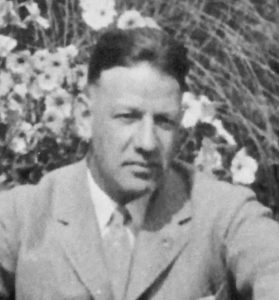
Sam Heiman
Heiman was born in 1884 in San Francisco and began his architectural career while in his early twenties. He became a licensed architect in 1920. From 1914 to 1919, Heiman was in practice with Mel I. Schwartz, and the firm designed small commercial buildings and homes in San Francisco. In 1922, The Architect and Engineer reported that Heiman was one of the busiest architects in San Francisco; he was so busy that he expanded his office space at 57 Post Street.
Heiman’s buildings in San Anselmo were designed predominately in the Spanish Colonial Revival Style which became popular after the 1915 California-Pacific Exposition in San Diego. Tile roofs, stucco exteriors, shaped parapets and decorative relief are characteristic of this style.
208 Sir Francis Drake Boulevard (Taqueria Mi Pueblo).
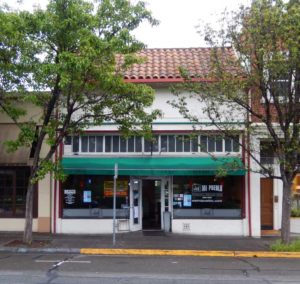
208 Sir Francis Drake, 2016
This side gable building with a tile hipped roof was designed and constructed as the headquarters for real estate agents Kent & Minto in 1923. The exterior was a pastel pink with elaborate stucco decoration on the upper level of the façade. The interior had the main office, a conference room and mezzanine.
526-536 San Anselmo Avenue.
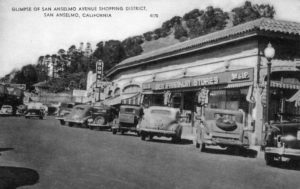
Raas-Esberg Building, 1940s
Sam Heiman designed this building for developer Frank Howard Allen in 1924. It was known as the Raas-Esberg Building after the financial backers and property owners Joseph C. Raas and Milton Esberg. It was a handsome building with six storefronts and a stucco exterior and red tile roof. Ben Franklin moved into the building in 1938 and was a longtime tenant. The exterior of building and the roof were “modernized” in the 1950s sadly obliterating Heiman’s original design.
324-332 Sir Francis Drake Boulevard.
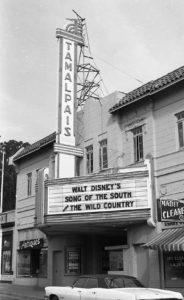
Tamalpais Theatre
In 1923, Heiman designed the San Anselmo Community Theater, later named the Tamalpais Theatre. Harold Stoner of the Lang Company Realty was also mentioned as an architect on the project, perhaps as a draftsman. Joseph C. Raas was the major investor. The building is two stories with a parapet which is framed by hipped tiled roof lines. The theater could seat a thousand. The theater closed in 1989 after the Loma Prieta earthquake, and the back theater section of the building was razed. Heiman’s son Warren, a San Anselmo resident, recalls that his family was always admitted to the theater for free.
610 Sir Francis Drake Boulevard.
Sam Heiman designed this building in 1924 for the Durham Garage which included a Dodge sales and showroom. Heiman described the building as being “the most modern type and will be unique in appearance tending more to the artistic than the heretofore plain standard garage.” A false front parapet hides the building’s flat roof. Marin Oil Burner Company, H. C. Little Heating & Sheet Metal, Clark’s Furniture and Pavilion Antiques were other businesses that operated in the distinctive building at the Hub.
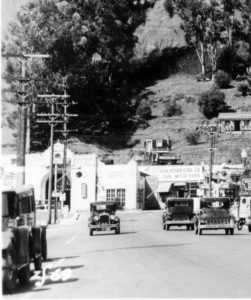
Durham Garage, 1930s
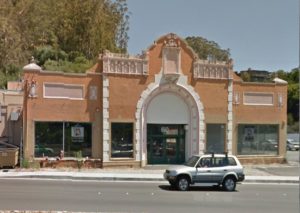
610 sir Francis Drake, 2016
1000 Sir Francis Drake Boulevard (Isabel Cook Community Center).
To meet the needs of the growing student population in San Anselmo, residents passed a school bond in late 1927, and the school district then engaged Sam Heiman to complete plans for a new school on what was then called Red Hill Avenue and now is Sir Francis Drake Boulevard. Red Hill School opened in 1929. It was renamed Isabel Cook School in 1949. The building had a prominent front entrance with a tower. In 1952, the school was remodeled to bring it up to earthquake standards set by the Field Act of 1939 and to add more classroom space. The front entrance and tower were eliminated, and likely the roof tiles were also removed at that time.
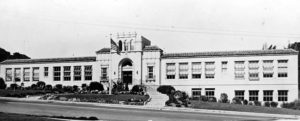
Red Hill School, 1930
In San Anselmo, Heiman also designed six homes in Hawthorne Hills in 1923, a concrete addition to Deysher & La Fargue (a vehicle repair shop next to the Durham Garage) in 1925, and a civic auditorium at Memorial Park in 1938 that was never constructed.
Elsewhere in Marin, Heiman was busy as well. In San Rafael, he drew the architectural plans for the Marin Masonic Lodge (1925), the Albert Building (1930) and a gymnasium for the San Rafael Military Academy, now the Old Gym at Marin Academy (1932); in Larkspur, the Larkspur Branch of the Bank of San Anselmo, now Bank of the West (1923) and the Larkspur Fire Station (1938); in Ross, Ross Hospital (1924); in Fairfax, the Fairfax Fire Station (1926); and in Mill Valley, a Studebaker garage (1924). There are perhaps other undocumented Heiman-designed buildings in Marin.
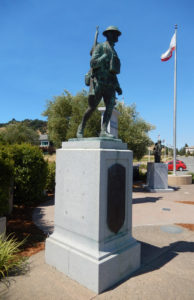
Doughboy Statue on the Avenue of the Flags
In 1921, the Marin County Ex-service Men’s Memorial Organization raised funds and commissioned artist Joseph J. Mora to sculpt a generic Doughboy soldier to commemorate those men who lost their lives in World War I. Sam Heiman was commissioned to design the concrete and marble base for the statue; he was also the model for the statue. Warren Heiman still has his father’s satchel that was worn while posing for the artist. The memorial, with the names of the 34 Marin men who died in the war, was in front of the Marin County Courthouse in San Rafael until 1971 when it was moved to the Avenue of the Flags at the Civic Center (see photo page 11).
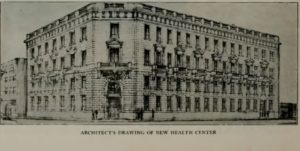
101 Grove
During his career, Sam Heiman designed commercial, industrial and apartment buildings in San Francisco and houses in many of the neighborhoods. His most well-known structure is probably the San Francisco Public Health Department at 101 Grove Street designed in 1931.
With his busy architectural practice, Heiman still found time for his family – his wife Dorothy and sons Warren and Lawrence. As a veteran of both WWI and WWII, he was active in the American Legion. In the 1940s, he taught drafting in the evening to the inmates at San Quentin Prison. On his death in 1947 at age 62, Warden Clinton T. Duffy wrote: “Sam not only taught drafting and blue print reading to the men, but he taught character and loyalty and sincerity. He was a great one to help others without their asking. If a man did not have the necessary materials or supplies to carry on with his course, Sam would buy them for him.”
Samuel Heiman certainly left his mark on San Anselmo and elsewhere in Marin with many of his fine buildings still surviving.

